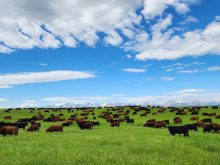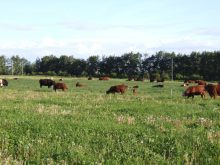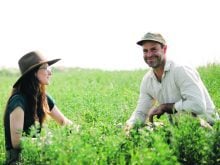GLADMAR, Sask. — Mark and Laura Hoimyr have changed the grazing system on their operation this year, moving to a more intensive system they hope will improve the soil.
They’ve typically put their cattle on pastures for one to two passes each year, trying to leave some vegetation to regrow.
“We’ve basically turned that on its head,” said Mark Hoimyr. “Now we’re trying to take everything. We’re going out with the thought in mind that we’re not coming back to it.”
The idea is to bunch up the cattle to increase the intensity of the grazing and use fewer acres each day. More even manure distribution and uniform trampling, and eliminating the opportunity for grazing selection, should result in a better use of the resource and more even recovery.
During a recent Saskatchewan Soil Conservation Association field day, the Hoimyrs demonstrated how their system works. They use homemade automatic risers to lift electric wires at pre-determined times of the day.
Barbed-wire, quips Mark, is only good for tattoos and country songs.
On this particular field the cattle are in 6.5-acre strips and typically move four times a day.
Each strip borders on an alley that leads to the water troughs so the animals have access to water at all times.
Hoimyr said cattle aren’t moved that often in every field. Some are only moved once or twice depending on the quality of grass and time of year.
Each morning the system is set up so that the fence lifts at the right time. Although there are commercial timing systems on the market, Hoimyr said he isn’t sure about investing in one until he sees if it works.
“The brain of it is a sprinkler timer you can get at Canadian Tire,” he explained.
It also includes PVC pipe and aircraft wire.
On top of the battery-powered timer sits a canister that is filled with compressed air. When the timer reaches its goal the air is released and pushes out a plug that has been holding back a trip wire. This triggers a spring that raises the electric fence and allows the cattle through.
The cattle have adapted to the system and Hoimyr said the most likely problem to occur is operator error.
There are a couple of other things to watch out for: if bumped, one of the seals on the canister can move and release the air; and, the wind can sometimes catch the riser.
Generally speaking, they are happy with how this first season has gone. The goal is to graze 10 months of the year and only feed hay bales during January and February.
Hoimyr said he thinks this system will allow an increase in stocking rate.
They turned to this system to build their soil.

“We kind of felt like even though we were managing to the best of our ability there was still something missing,” Hoimyr said. “We weren’t getting the growth and new seedlings. The cattle were healthy and doing well but we weren’t moving the health of the soil forward anymore.”
Under the previous system, by leaving vegetation, they couldn’t see the bare patches that weren’t filling in. On lighter land and hilltops it’s tricky to increase organic matter but he said they are already seeing some change.
“The goal is to never be able to see the soil,” he said during the field day. “It might be idealistic but we’re still trying.”
He also said the “perfect graze” rarely happens and producers have to be OK with that.
They expect to see better growth and greater soil improvements over time and definitely with more moisture. Although the region had some timely rains, it is still dry.
“With this heat, I can say I’m resting the grass but that’s not what’s happening under the soil,” he said.
Hoimyr also said producers have to accept they may have a little more trouble keeping body condition score up on some cattle. They found that some of their older and younger animals were fine when they got lush grass all the time but had more trouble when they were asked to clean up a day’s worth of feed, some of which they wouldn’t likely have eaten under other circumstances.
He added that some producers have a hard time considering this type of grazing system.
That includes those who believe in leaving some grass to jump-start regrowth and those who move cattle only every few weeks.
“I’m mostly convinced but still need to see a few more years until I’m completely sold,” he said.
















